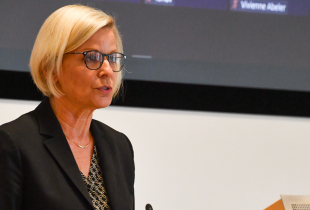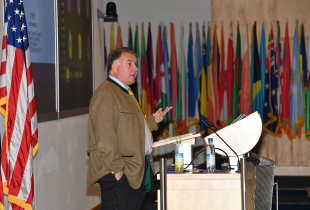
The Sino-Russian Military Nexus in Outer Space: Strategic Implications?
Context
In the Cold War the Soviet Union and the U.S. were leading space powers, largely competing, but also in the 1970s cooperating. This cooperation continued after the collapse of the Soviet Union, with the U.S. subsidizing the Russian space program in order to prevent the spread of military-relevant technologies. The construction of the International Space Station (ISS) in the 1990s and 2000s and U.S. reliance on Russian Soyuz rockets after the closure of its Space Shuttle program in 2011 (until 2020 when the U.S. regains the capability through SpaceX Dragon-2) are examples of such continued cooperation.
In recent years we have witnessed a marked Russian reorientation away from Russo-U.S. space cooperation and its withdrawal from participation in many international projects, such as the joint lunar project and ISS (by 2025), towards Russian-Chinese space cooperation. In 2019 Roscosmos and China National Space Administration agree coordination between the lunar exploration missions Luna-Resurs-1 and Chang’e 7 (嫦娥七号). China and Russia, as second and third placed space powers respectively, cooperate together, building on the legacy of the Sino-Soviet Treaty of Friendship in the 1950s. As before, both look to counter-balance the U.S. in space and challenge its primacy in international politics. What are the implications of this Sino-Russian space nexus for strategic competition?
Russia
The drivers of Russian cooperation with China are numerous: 1. Russia’s technology is increasingly obsolete; 2. budgetary cuts and corruption diminish solo-efforts; 3. the need to maintain Great Power status and the idea of breaking encirclement; 4. China agreeing to an intellectual property accord in 2016, signed in 2017, outlining space cooperation, special materials development, remote sensing, heavy rocket engine technological transfers and cooperation. Russia sacrifices international cooperation and civil use of space and instead prioritizes military use, where it can still compete with the United States. As a result, Russia’s focus is on building military capabilities that allow it to remain strategically relevant. The core of Russian “counter space weapons” include:
- The S-400 system, capable of interception in the lower reaches of the low orbit (185km), was transferred to China following an agreement in 2014. First deliveries occurred in 2018, with a suspension in 2020 until exports to India coordinated.
- Nudol anti-satellite (ASAT) missile system. This system was initiated in 2009, testing began in 2013 and most recently a “combat” test took place on 15 November 2021 against a Russian Kosmos 1408 satellite, demonstrating Russia’s ability to destroy one of its defunct Cold War-era satellites in low Earth orbit. This system allows Russia the capability to destroy satellites above its territory. It may acquire the official designation as the S-550 air defence missile system and be fully deployed in 2022.
- Russia also focusses on Rendezvous and Proximity Operations (RPO), with the ability to undertake co-orbital manoeuvres (change orbit, follow and destroy its opponents’ satellites).
- Jamming satellite signals, work on space lasers and other directed energy weapons.
- Kinetic MiG-31BM air-launched missiles with the potential for anti-satellite capability (Burevestnik program).
China
China has the ambition to be the leading global space power by the mid-2040s. Assessing China’s configuration of capability in space is hard to clarify and complicated by numerous factors, not least: 1. civil and military dual use launches and satellites; 2. the 2016 policy of civil-military fusion under President Xi, which focuses on AI, semi-conductors and other leading technologies as well as space; 3. gauging the impact of commercial developments on military usage and understanding how military capability developments can and may be cloaked by commercial progress; 4. new constellations of smaller vs older more vulnerable satellites; 5. overlapping anti-ballistic missile and anti-satellite technologies; 6. the secretive nature of Chinese-Russian decision-making and technological cooperation. In the military sphere China develops:
- ASAT weapons capable of disrupting/destroying satellites in geo-stationary orbit.
- SC-19 anti-satellite testing in 2007; DN-3 2018 ex-atmospheric missile interception; 2021 testing of a hypersonic missile with a potential nuclear warhead.
- Cyber-attacks, jamming, GOPS-spoofing (manipulating false data with attendant difficulties in attribution), and demonstration of PRO capabilities.
- Space plane tested in late 2021.
- An offensive fractional orbital bombardment system that can attack the U.S. from the south.
Characteristics of Sino-Russian Space Cooperation
Asymmetries
- In 2020 Russia undertook 25 launches (17% global share) while China 55. China’s space budget in 2020 was $8.9bn and second to US’s, while Russia’s was $2.7bn.
- Russia focus two thirds of its smaller budget on military capability that itself is reliant on Soviet era projects from the 1970s (e.g. Angara A5M engines), whereas China also exploits commercial opportunities and undertakes innovation.
- Russia can offer China operational combat experience (use of S-400s in Syria, jamming of drone attacks) which China lacks, having not itself undertaken combat operations since the 1980s.
Synergies
- GNSS – Beidou and Glonass complement each other and by combining 35 Beidu and 24 Glonass satellites, together Russia and China have a system capable of competing with the 31 satellite that constitute GPS.
- Russian stations in China and Chinese stations in Russia can offer each strategic early warning against the US and so enhance the deterrence capabilities of both.
- The creation of a Sino-Russian space-based cooperative ecosystem creates soft power and legitimacy advantages for both. This generates the ability to attract the support of third parties, which in turn can be translated into diplomatic influence and UN votes.
- Both use space in symbolic and instrumental ways. For China space leadership signals the “century of humiliation” is over, and represents a shift in strategic thinking, placing Xi-era exquisite technology and innovation over Mao-era quantity (“more soldiers than the enemy has bullets”; “more is better”). For Russia, the Soviet space legacy can be leveraged symbolically to promote current Great Power status, as evidenced by the launch of Sputnik-V and Russian COVID-diplomacy, or the construction of AI robots that are named “Leontov” and “Gagarin.” Russia instrumentalises space through demonstrating ASAT weapons capabilities ahead of any potential international prohibitions. This also ensures Russia a “seat at the table” in any future negotiations on restricting ASAT testing and use.
Conclusions
The main legal document – The Outer Space Treaty, formally the Treaty on Principles Governing the Activities of States in the Exploration and Use of Outer Space, including the Moon and Other Celestial Bodies (27 January 1967) – is obsolete and space-faring powers do not want to negotiate towards a new legally binding regulatory system. The U.S. backed a UK sponsored resolution for responsible behavior in space and an “Open-Ended Working Group” (OEWG) to begin discussion on responsible behaviour. In addition, Defense Secretary Lloyd Austin laid out five “Tenets of Responsible Behavior” that the DoD would follow (7 July 2021), highlighting best practice and setting normative standards. Russia and China back a “Treaty on Prevention of the Placement of Weapons in Outer Space and of the Threat or Use of Force Against Outer Space Objects” (PPTW). This proposal bans the placement of weapons in space but not the deployment of ground-based direct-ascent weapons or their testing.
The strategic importance of Russian-Chinese space cooperation is growing rapidly and creates sensitive policy challenges for the United States. In 2002 Everett Dolman conceptualized space-based competition in terms of zero-sum neo-classical geopolitics – astropolitik – suggesting that: “Who controls low-earth orbit controls near-Earth space. Who controls near-Earth space dominates Terra. Who dominates Terra determines the destiny of humankind.” By 2022, China and Russia cooperate to militarize space as an asymmetric response and challenge to U.S. technological superiority and its current primacy built on a space-enabled modernity paradigm. Rather than underscoring a need to occupy the commanding heights of lower earth orbit, this seminar demonstrates that space power is found in fusion (civil-military in China’s case, public-private in the case of the United States), constellations and connected systems and responsible and capable allies (NATO, Five-Eyes). Connectivity, cooperation and functional innovation provides the underlying dynamics that drives the logic and evolution of current strategic competition in space.
GCMC, January 19, 2022.
About the Author
Dr. Paweł Bernat is a Senior Lecturer of international security studies at the Faculty of Aviation Safety in Military University of Aviation, Dęblin, Poland. His areas of expertise include strategic aspects of outer space, with the special focus on commercialization, militarization, and weaponization of Earth orbit, and proxy and hybrid warfare in Eastern Europe. He is a co-founder and Vice President of Andarta Education for Security Foundation and a member of the Polish Space Professionals Association.
Dr. Mark Hilborne is a lecturer at King’s College London in the Defence Studies Department, and holds an MPhil and PhD from Cambridge University, and did his undergraduate at UBC in Vancouver. Dr Hilborne’s research interests and publications concentrate on security, strategic stability and arms control, with a focus on outer space as well as nuclear deterrence and proliferation. Dr Hilborne is also the convenor of the Space Security Research Group at King’s. Prior to moving to King’s he also worked at the University of Birmingham and UNIDIR in Geneva. In addition to publishing on space security issues, Dr Hilborne has been involved with a number of discussions with the MoD, FCDO and other governmental offices on UK space policy, and has appeared in TV, radio and newspaper media.
Dr. Graeme P. Herd is a Professor of Transnational Security Studies and Chair of the Research and Policy Analysis Department at the George C. Marshall European Center for Security Studies (GCMC). Dr. Herd runs a monthly Seminar Series which focuses on Russian crisis behavior, the Russia-China nexus, and its the implications for the United States, Germany, friends and allies. Prior to joining the Marshall Center, he was the Professor of International Relations and founding Director of the School of Government, and Associate Dean, Faculty of Business, University of Plymouth, UK (2013-14). Dr. Herd has published eleven books, written over 70 academic papers and delivered over 100 academic and policy-related presentations in 46 countries.
The George C. Marshall European Center for Security Studies
The George C. Marshall European Center for Security Studies in Garmisch-Partenkirchen, Germany is a German-American partnership and trusted global network promoting common values and advancing collaborative geostrategic solutions. The Marshall Center’s mission to educate, engage, and empower security partners to collectively affect regional, transnational, and global challenges is achieved through programs designed to promote peaceful, whole of government approaches to address today’s most pressing security challenges. Since its creation in 1992, the Marshall Center’s alumni network has grown to include over 15,000 professionals from 157 countries. More information on the Marshall Center can be found online at www.marshallcenter.org.
The articles in this seminar series reflect the views of the authors and are not necessarily the official policy of the United States, Germany, or any other governments.

